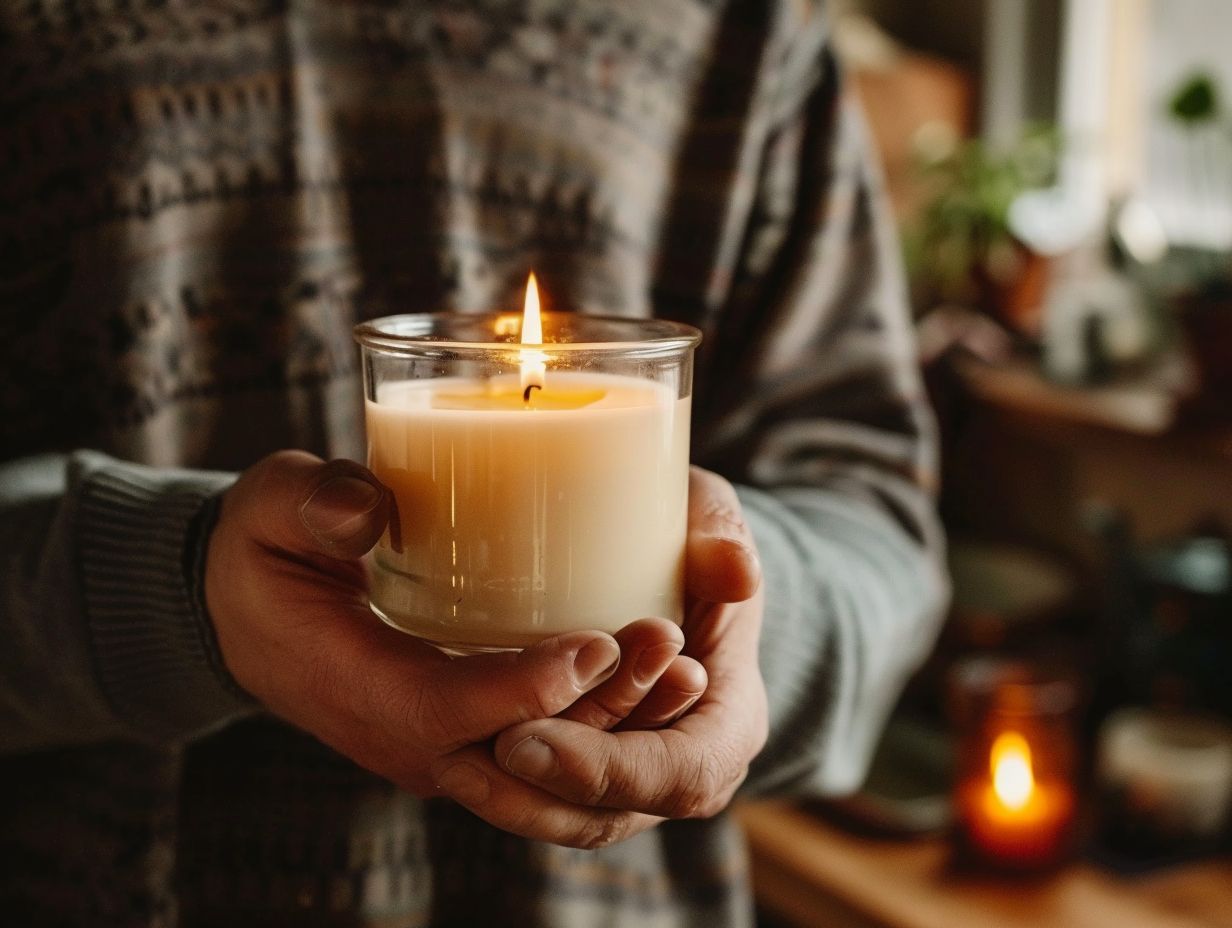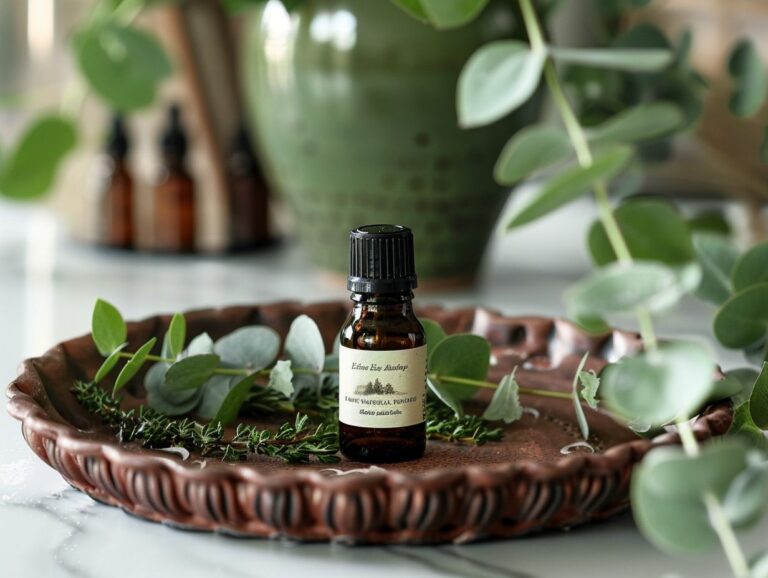Can You Make Scented Candles Without Essential Oils
Curious about scented candles but hesitant to use essential oils? You’re in luck!
This article delves into the world of scented candles without essential oils, discussing alternative ingredients, benefits, risks, and best scents to use.
Discover cost-effective solutions and versatile scent options to create beautiful candles using fragrance oils, natural ingredients, spices, and herbs. Elevate your candle-making game without the need for essential oils.
Key Takeaways:
What Are Scented Candles?
Scented candles are candles that are infused with various fragrances to create an aromatic ambiance when burned. These candles come in a wide range of scents, from floral and fruity to spicy and woody, catering to different preferences and moods.
Scented candles have gained immense popularity not just for their pleasant aroma, but also for their ability to relax, rejuvenate, and set a calming atmosphere in any space.
Whether you prefer the soothing scent of lavender for unwinding after a long day or the invigorating aroma of citrus to boost your energy, there’s a candle fragrance to suit every occasion and mood.
The diverse array of available scents allows you to transform your home into a personalized sanctuary that appeals to your senses.
What Are Essential Oils?
Essential oils are natural extracts derived from plants, flowers, or fruits through processes like distillation or cold pressing. These oils carry the essence and aroma of the source material and are commonly used in aromatherapy, skincare, and fragrance products.
Essential oils have a rich history, with origins dating back centuries, where they were utilized for their therapeutic properties. Extraction methods vary depending on the plant, with steam distillation being one of the most common techniques to obtain these potent oils. Each essential oil boasts a unique scent profile and a range of potential benefits, from promoting relaxation and improving sleep quality to aiding in skincare routines and boosting mood.
Can You Make Scented Candles Without Essential Oils?
Yes, it is possible to make scented candles without essential oils by using alternative fragrances and natural ingredients. DIY enthusiasts can create custom scents using various ingredients like spices, herbs, and fragrance oils for unique candle-making experiences.
When opting for alternative fragrances, consider experimenting with dried flowers, citrus peels, or vanilla beans to infuse your candles with enticing scents. Experimentation is key in discovering the perfect combination that resonates with your personal preferences.
For those looking to embark on a DIY candle-making journey sans essential oils, utilizing beeswax or soy wax as the base can provide a lovely foundation for your fragrances to shine through. Customization is at the forefront of this process, allowing you to tailor each candle to suit different moods and occasions.
What Are the Alternatives to Essential Oils?
When looking for alternatives to essential oils for scented candles, consider using fragrance oils, spices like cinnamon or cloves, herbs such as lavender or rosemary, and other natural ingredients like vanilla extract or citrus peels.
One excellent substitute for essential oils in candle-making is fragrance oils. These are synthetic oils that are specifically formulated for candle-making and come in a wide range of scents.
- Spices, such as cinnamon or cloves, can add a warm and cozy aroma to your candles.
- Herbs like lavender or rosemary not only provide pleasant scents but also add a touch of natural beauty to your candles.
- Natural extracts such as vanilla extract or citrus peels can infuse your candles with sweet or refreshing fragrances.
Experimenting with these alternatives can add a unique twist to your candle-making endeavors.
What Are the Benefits of Making Scented Candles Without Essential Oils?
There are several advantages to making scented candles without essential oils. These benefits include being cost-effective, suitable for individuals with allergies to essential oils, and offering a wide range of versatile scents that may not be achievable with essential oils alone.
When opting to create scented candles without essential oils, one major aspect to consider is the substantial cost savings involved. Essential oils can be quite pricey, and by using alternative fragrance options, the overall production expenses significantly decrease, making this DIY project more budget-friendly.
For those sensitive to essential oils or prone to allergic reactions, non-essential oil-based candles present a perfect solution. The absence of potent essential oils reduces the risk of triggering allergies or sensitivities, allowing a broader audience to enjoy the soothing ambiance of scented candles.
The absence of essential oils opens up a world of scent combinations that may not be readily available through essential oils alone. From unique food-inspired fragrances to complex blends mimicking popular perfumes, the versatility in creating scented candles without essential oils is truly limitless.
Cost-effective
Making scented candles without essential oils can be a cost-effective option for crafters and DIY enthusiasts who want to create aromatic candles on a budget. By using alternative fragrances and natural ingredients, individuals can save money while still enjoying the creative process.
One budget-friendly approach is to repurpose old candles by melting them down and adding fragrance oils. This not only reduces waste but also cuts down on the cost of purchasing new materials. Incorporating herbs and spices like dried lavender, vanilla beans, or cinnamon sticks can infuse the candles with unique scents without breaking the bank. Craft stores often offer discounts on candle-making supplies, enabling enthusiasts to stock up on essentials without overspending. Considering these economical methods can result in beautifully scented candles that are both affordable and personalized.
Allergen-free

These allergen-free candle options are crafted with precision, ensuring that the ambiance they create does not compromise the well-being of sensitive individuals. The absence of essential oils in the manufacturing process significantly diminishes the chances of respiratory irritation or skin reactions that can be common with traditional scented candles. Certified as safe for allergen-sensitive individuals, these candles cater to a growing demand for products that prioritize health and wellness without sacrificing the joy of a fragrant space.
In addition, these candles without essential oils offer a wider range of scents, from fresh linen to citrus bursts, each carefully formulated to please the olfactory senses without causing discomfort. The attention to detail in selecting alternative fragrance sources underscores the commitment to providing an inclusive and enjoyable experience for all candle enthusiasts, regardless of their sensitivities. Embracing the diversity of preferences and needs, these allergen-free candle options open up a world of possibilities for creating inviting atmospheres safely and responsibly.
Versatile Scents
Crafting scented candles without essential oils offers a wide range of versatile scent options that go beyond traditional aromas.
By exploring a plethora of fragrance oils in combination with spices, herbs, or even fruits, individuals can craft candles with enticing scent compositions that spark creativity and evoke nostalgia.
From warm and comforting vanilla undertones to invigorating citrus notes or even the cozy embrace of freshly baked cookies, the possibilities are virtually endless when it comes to designing candles without essential oils.
What Are the Risks of Using Essential Oils in Scented Candles?
While essential oils are popular in scented candles, there are risks associated with their use. These include potential skin irritation, respiratory problems from inhaling concentrated oils, and fire hazards due to the flammability of certain essential oils. “
It’s essential to be aware of these risks to ensure safe usage. One of the main concerns is skin sensitivity, as some individuals may experience adverse reactions when essential oils come into direct contact with their skin.
Testing a small amount of the oil on a small patch of skin before widespread application can help identify any potential sensitivity.
Inhaling concentrated oils can lead to respiratory issues, especially in those with pre-existing respiratory conditions. In terms of fire safety, essential oils with low flashpoints pose a higher risk of igniting if exposed to an open flame.
Practicing caution and using oils in well-ventilated areas can minimize these dangers while enjoying the benefits of scented candles combined with essential oils.
Skin Irritation
One of the risks of using essential oils in scented candles is the potential for skin irritation, especially for individuals with sensitive skin. Direct contact with concentrated oils can cause redness, itching, or allergic reactions on the skin.
It’s crucial to be aware of the possible effects of essential oils on your skin before lighting up scented candles. Skin sensitivities can vary greatly from person to person, meaning that what works for one might irritate another. Consider conducting a patch test on a small area of skin before using a new scented candle extensively. In case of any adverse reactions, discontinue use immediately and seek medical advice.
Respiratory Issues
Inhaling essential oils from scented candles can pose respiratory risks, particularly for individuals with asthma or allergies. The strong aroma and volatile compounds in some essential oils may trigger breathing difficulties or allergic reactions in sensitive individuals.
When burning scented candles containing essential oils, it releases vapors that can irritate the respiratory system, leading to symptoms like coughing, wheezing, or shortness of breath. These symptoms are especially concerning for individuals with preexisting respiratory conditions such as asthma. It’s essential to be cautious when using scented candles in enclosed spaces, as inadequate ventilation can exacerbate respiratory issues. Always opt for candles made with natural, non-toxic ingredients and consider using an air purifier to maintain indoor air quality.
Fire Hazards
Certain essential oils used in scented candles can present fire hazards due to their flammability. Oils with low flash points or high volatile content may increase the risk of candle flames becoming too intense or causing unexpected flare-ups.
When ignited, these oils can accelerate a fire’s spread due to their high flammability, posing a significant safety concern. It is crucial for candle makers and users to be aware of the potential risks involved. Fire safety precautions should be taken seriously, such as keeping candles away from flammable materials, never leaving them unattended, and placing them on stable, heat-resistant surfaces.
Using proper candle holders designed to contain dripping wax can help prevent accidental fires. Being proactive in fire risk mitigation strategies, like trimming wicks to the correct length and following manufacturer guidelines, can reduce the likelihood of accidents.
How to Make Scented Candles Without Essential Oils?
Creating scented candles without essential oils is a rewarding DIY project that can be achieved using a variety of alternative ingredients. Whether opting for fragrance oils, natural extracts, spices, or herbs, the process allows for personalized and unique candle-making experiences.
Once you have selected your preferred ingredient, the next step involves melting the wax in a double boiler setup. Beeswax or soy wax are popular choices for their clean-burning properties and ability to hold scents well. After melting the wax to the desired temperature, it’s time to add your chosen scent element. Whether you prefer the comforting aroma of vanilla or the invigorating scent of citrus, carefully measure and stir in the fragrance to ensure an even distribution.
Next, carefully pour the fragranced wax mixture into your chosen candle container, being mindful of any wicks you have already prepared. Allow the candles to cool and solidify completely before trimming the wick to the desired length.
Once your candles are ready, consider customizing them further by decorating the containers with dried flowers, ribbons, or labels. Not only will these embellishments enhance the visual appeal of your candles, but they will also make lovely gifts for friends and family. Experiment with different scent combinations and decorative elements to create a signature style that reflects your personal preferences and creativity.
Using Fragrance Oils

When using fragrance oils in candle-making, it’s important to understand that these oils do not possess the same therapeutic benefits as essential oils. They excel in fragrance variety, making it easier to create unique and captivating scents for your candles.
The application of fragrance oils differs slightly from essential oils. With fragrance oils, you may find that you need to use less oil to achieve a strong scent throw due to their concentrated nature.
Using Natural Ingredients
Incorporating natural ingredients like herbs and spices into scented candles offers a botanical and aromatic twist to traditional candle-making. From dried lavender to cinnamon sticks, these elements add unique scents and visual appeal to homemade candles.
Herbs and spices bring a touch of nature into your living space, creating a cozy and comforting ambiance. Experimenting with rosemary, cloves, or chamomile not only infuses your candles with delightful aromas but also adds a personal touch to your creations. By using natural ingredients, you can avoid synthetic fragrances and chemicals, ensuring a healthier environment. The versatility of these organic elements allows you to tailor the scents and aesthetics of your candles to match your preferences or the seasons. Whether you prefer vibrant florals or warm spices, there is a wide array of herbs and spices to choose from in your candle-making endeavors.
Using Spices and Herbs
Spices and herbs can infuse scented candles with rich, earthy aromas and botanical fragrances. From clove and nutmeg to rosemary and mint, these natural elements add depth and complexity to candle scents without the need for essential oils.
Exploring the world of spice-infused candles opens up a plethora of creative possibilities. Cinnamon, with its warm and inviting scent, can evoke feelings of comfort and coziness, perfect for setting a relaxing ambiance. On the other hand, lavender brings a sense of calm and tranquility, ideal for meditation spaces or bedrooms. Sage lends a refreshing herbal note, while thyme adds a touch of freshness reminiscent of a blooming garden.
What Are the Best Scents to Use in Scented Candles Without Essential Oils?
When making scented candles without essential oils, some of the best scents to consider include citrus fruits for a refreshing aroma, vanilla for a sweet and comforting fragrance, and cinnamon for a warm and cozy scent.
These scents are popular choices as they provide a range of olfactory experiences that appeal to a wide audience.
- Citrus fruits, such as lemon and orange, offer a zesty and invigorating scent that is perfect for uplifting moods and creating a fresh atmosphere.
- Vanilla, with its rich and creamy aroma, is a timeless favorite that exudes warmth and homeliness, making it ideal for relaxation and creating a calming ambiance.
- Cinnamon, a spicy and aromatic option, brings a sense of coziness and comfort, perfect for creating a welcoming environment during colder months.
Mixing these scents can also create unique blends that cater to individual preferences, allowing for a customized candle-making experience that is both enjoyable and versatile.
Citrus Fruits
Citrus fruits like lemon and orange bring a vibrant and zesty scent to candles, uplifting the atmosphere with their refreshing and energizing notes. These fruits are popular choices for creating invigorating and mood-boosting candle fragrances.
Known for their uplifting qualities and revitalizing properties, citrus fruits play a significant role in enhancing the ambiance of any space. Their lively essence not only adds a burst of freshness but also helps in creating a sense of positivity and joy. When used in candles, these fruits infuse the room with a lively and invigorating aroma that can lift spirits and boost energy levels.
To incorporate citrus fruits into candle-making, one can either use citrus zest for a natural touch or opt for citrus peel for a stronger fragrance. Extracting the oils from these fruits can be done through cold-pressing methods, ensuring that the candles carry the authentic citrusy notes. For a DIY approach, consider mixing citrus oils with soy wax and pouring them into candle molds for a customized and refreshing scent experience.
Vanilla
Vanilla is a classic scent for candles, known for its warm and comforting aroma that creates a cozy ambiance.
Many individuals are drawn to the allure of vanilla due to its ability to evoke nostalgic memories of homemade treats and childhood comfort. Without the use of essential oils, vanilla can still infuse candles with its signature notes of sweetness and luxury. To incorporate vanilla into scented candles, vanilla extract or vanilla-infused wax can be utilized to achieve that rich and inviting fragrance. This approach ensures a natural and chemical-free option for those seeking a pure vanilla experience in their candle selection.
Cinnamon
Cinnamon lends a spicy and cozy fragrance to candles, perfect for creating a warm and inviting atmosphere in any space. The rich and sweet aroma of cinnamon enhances the ambiance, making it an excellent choice for scented candles without essential oils.
One of the most enticing aspects of using cinnamon in candle scents is its ability to evoke feelings of comfort and nostalgia. When cinnamon-infused candles are lit, they fill the room with a familiar and comforting scent that instantly soothes the senses. This aromatic spice adds a touch of warmth and depth to the overall ambiance, making it an ideal choice for cozy evenings or festive gatherings.
Frequently Asked Questions
Can You Make Scented Candles Without Essential Oils?
Yes, it is possible to make scented candles without essential oils. There are alternative fragrance options available that can give your candles a pleasant scent without using essential oils.
What Are Some Alternatives to Essential Oils for Scented Candles?
Some alternatives to essential oils for scented candles include fragrance oils, herbal extracts, spices, and dried flowers. Each of these options can provide a unique and long-lasting scent for your candles.
Are Natural Fragrances Safe to Use in Scented Candles?
Yes, natural fragrances such as herbal extracts and dried flowers are safe to use in scented candles. However, it is important to carefully research and choose reputable suppliers to ensure the safety and quality of these fragrances.
Can You Make Scented Candles Without Any Added Fragrances?
Yes, you can make unscented candles using only natural waxes, such as beeswax or soy wax. These candles will have a subtle natural scent, but will not have any added fragrances.
What Are the Benefits of Making Scented Candles Without Essential Oils?
Making scented candles without essential oils allows individuals who are sensitive to certain scents to still enjoy the ambiance of a candle. It also allows for a wider range of fragrance options and can be more cost-effective.
Can You Use Artificial Fragrances in Place of Essential Oils for Scented Candles?
Yes, you can use artificial fragrances in place of essential oils for scented candles. However, it is important to choose high-quality, skin-safe fragrances and to use them in moderation to avoid any potential health risks.









One Comment